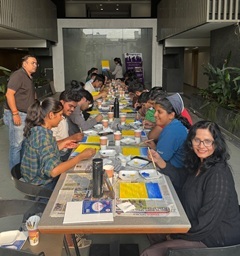Shiva is Truth, Shiva is Infinite,
Shiva is eternal, Shiva is God,
Shiva is Omkar, Shiva is Brahman,
Shiva is Shakti, Shiva is Bhakti
The word ‘Nataraja’ is derived from the Sanskrit words ‘Nata’ which means dance, and ‘Raja’ which means king. Hence, Nataraja is also known as the King of Dance. The depiction of Lord Shiva as Nataraja is one of the most iconic representations of Hindu mythology, which has been used in art, literature, and philosophy for centuries.


The image of Nataraja portrays Lord Shiva with four arms, holding various objects that represent his power and authority. The upper right hand holds a drum or ‘damru’, which represents the sound of creation. The upper left hand holds a flame or ‘agni’, which represents the destructive force. The lower right hand is held in the ‘abhaya mudra’, which represents protection and fearlessness. The lower left hand is pointed towards the raised foot, which represents liberation from the cycle of birth and death.
The most striking feature of the Nataraja image is Lord Shiva’s dancing posture. He is shown standing on one foot, with the other raised and pointed towards the left. His body is bent at the waist, and his hair is flowing in all directions, representing the force of creation. The circle of fire that surrounds Lord Shiva represents the cosmic cycle of birth and death, and the lotus on which he stands symbolizes purity and detachment from the material world. The flowing hair and the snakes around his neck represent the unbridled force of nature, which is harnessed and controlled by the divine.
The Nataraja pose of Lord Shiva has a fascinating story behind it. According to Hindu mythology, there was once a great demon named Apasmara, who was a personification of ignorance and forgetfulness. Apasmara was causing chaos and disorder in the world by making people forget their true nature and causing them to indulge in vices and immorality.
To put an end to Apasmara’s reign of chaos, Lord Shiva appeared in his Nataraja form and began to perform his cosmic dance. As he danced, his foot came down hard on Apasmara, crushing the demon and symbolizing the triumph of knowledge over ignorance.
The dance of Nataraja is also said to represent the five aspects of divine energy – creation, preservation, destruction, illusion, and liberation. The drum that Lord Shiva holds in his hand symbolizes the sound of creation, while the flame symbolizes the force of destruction. The raised foot symbolizes the force of illusion, which Lord Shiva has conquered, and the lower hand in the ‘abhaya mudra’ represents the protective power of the divine.
The Nataraja pose of Lord Shiva has become a powerful symbol of Hindu mythology, representing the triumph of knowledge over ignorance, the cosmic dance of creation, preservation, and destruction, and the complexity and interconnectivity of the universe. It continues to be depicted in art, literature, and philosophy, serving as a reminder of the power and majesty of the divine.
The Nataraja image is also associated with various philosophical and spiritual concepts. The cosmic dance of Nataraja is said to represent the constant cycle of creation, preservation, and destruction that occurs in the universe. It also represents the idea of ‘Samsara’, the cycle of birth, death, and rebirth that all living beings go through. The Nataraja image is also associated with the idea of ‘Shakti’, the creative energy that is required for the maintenance and sustenance of the universe.

Create, Connect, Collaborate!
